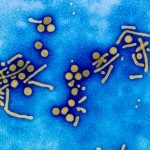Lien vers Pubmed [PMID] – 7615547
J. Biol. Chem. 1995 Jul;270(29):17423-8
Double-stranded RNA-dependent protein kinase (PKR) is suggested to play an important role in both the antiviral and antiproliferative arms of the interferon response. To gain insights into the molecular mechanisms underlying PKR’s growth regulatory properties, we examined the biological and biochemical properties of PKR variants containing either a mutation in catalytic domain II (PKR-M1) or a deletion of RNA binding domain I (PKR-M7) in both reticulocyte translation extracts and in vitro kinase assays with purified reagents and compared these results with those using the same mutants stably expressed in vivo. While wild-type PKR (PKR-WT) efficiently inhibited mRNA translation in a reticulocyte extract, the inactive PKR-M1 had no effect. The PKR-M7 mutant was modestly inhibitory in this assay. The PKR-M1 variant was able to reverse the translational inhibitory effects and increased eukaryotic initiation factor (eIF)-2 alpha phosphorylation levels caused by addition of double-stranded RNA to reticulocyte extract, whereas PKR-M7 could not. Both PKR-M1 and PKR-M7 functioned as transdominant inhibitors of PKR-WT in our in vitro kinase assays. While the inhibition by PKR-M1 required a vast excess of mutant to shut down PKR function, PKR-M7 inhibited PKR-WT at approximately stoichiometric levels. To complement these experiments, we compared growth rates and alpha phosphorylation levels in transformed cell lines overexpressing either PKR-M1 or PKR-M7. Levels of endogenous eIF-2 alpha phosphorylation were significantly more diminished in PKR-M7 overexpressing cells compared with PKR-M1. These paradoxical data will be discussed in terms of the potential molecular mechanisms underlying malignant transformation caused by the PKR variants.
